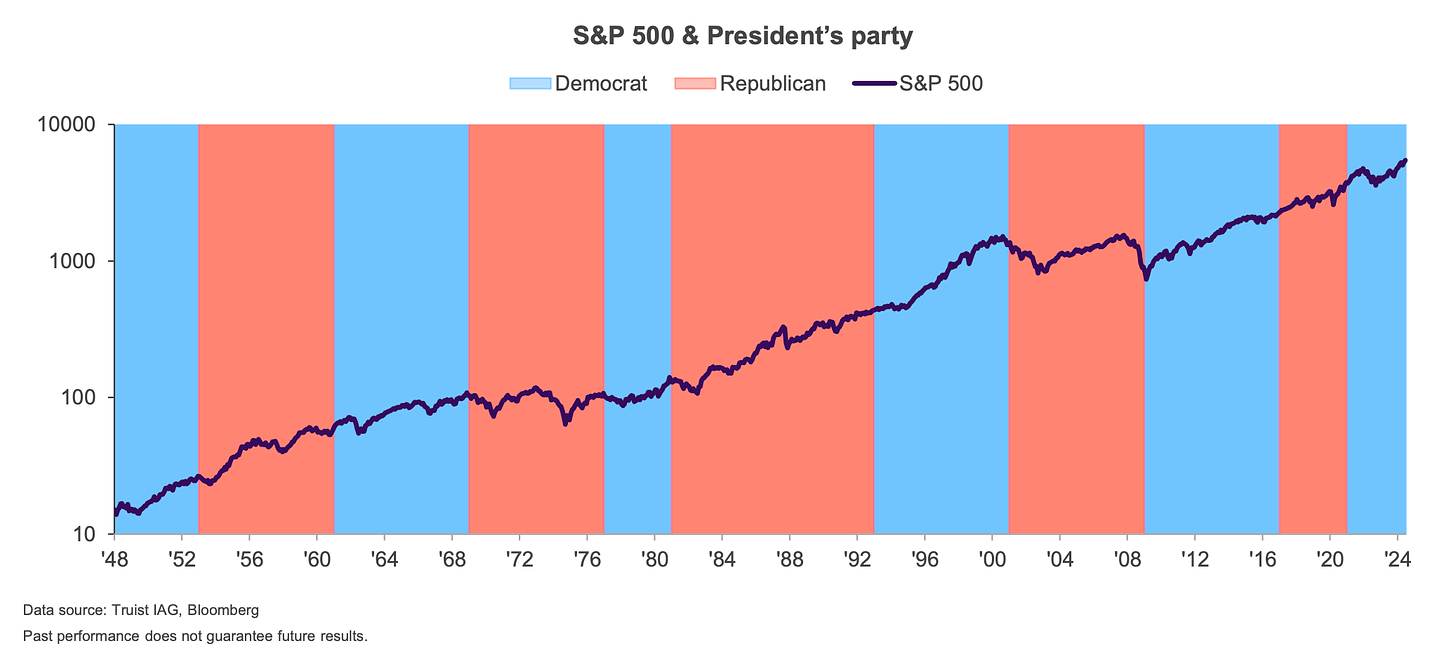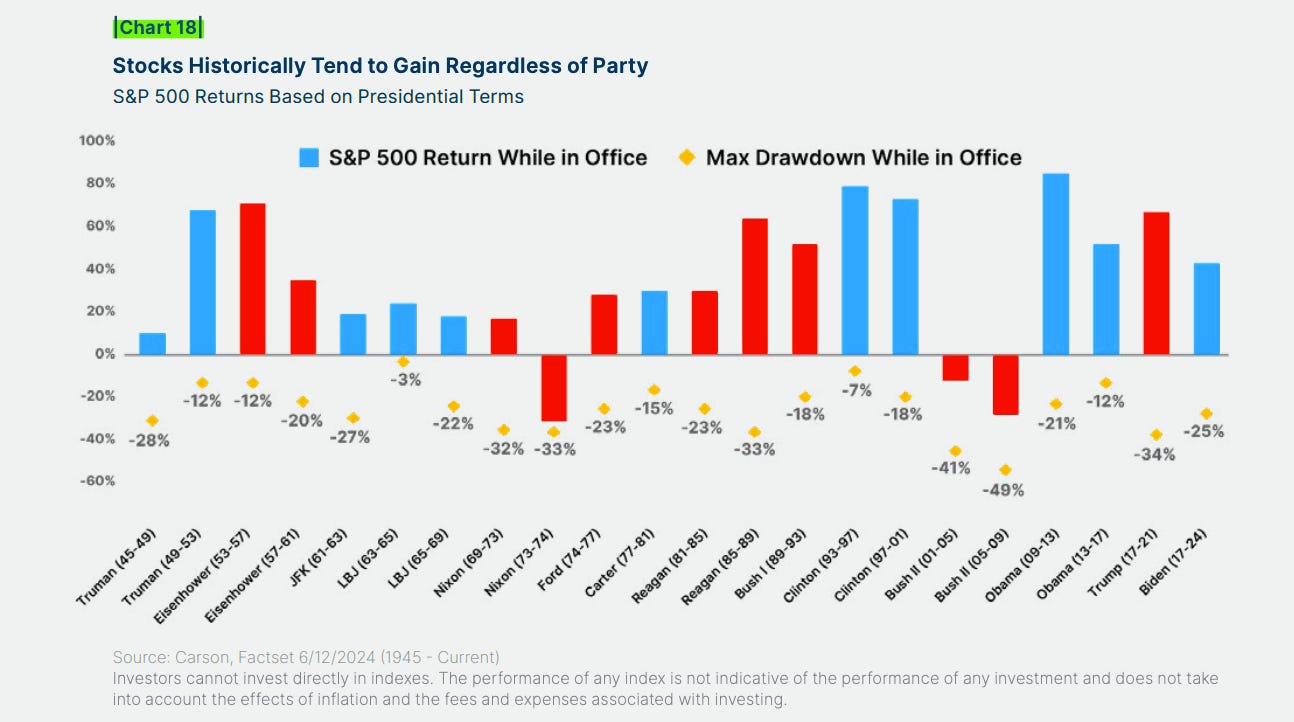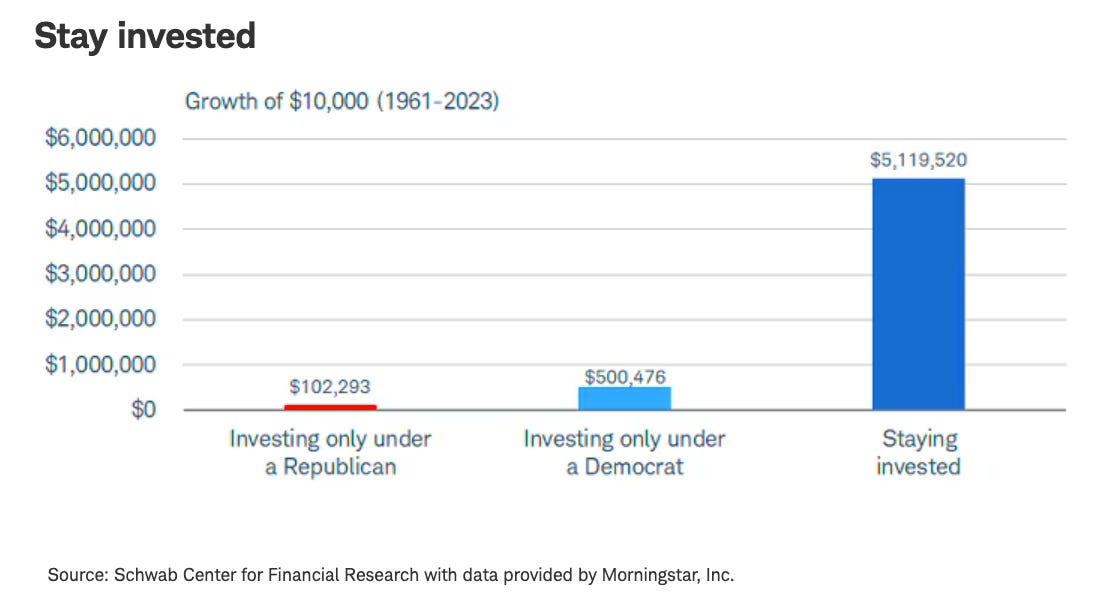Is a U.S. president from one political party better for the stock market than one from another party?
If only things were that simple.
The answer to this question often varies depending on whom you ask. And most answers will come with all sorts of caveats including: “Well, this president inherited the policies of the last president” or “That president’s term was affected by an exogenous shock” or “Does the president’s party control Congress?” or “Are we measuring from Election Day or Inauguration Day?” and so on.
Here’s my answer: History suggests that a U.S. president’s political slant may not be as important for stock market performance as you might assume.
Consider this simple chart from Truist’s Keith Lerner. It’s the trajectory of the S&P 500 since 1948 with periods shaded depending on the President’s political party. There aren’t any obvious patterns that jump out — except for the fact that the market spends a lot of time trending higher.
The stock market usually goes up. (Source: Truist)
“Markets have presented opportunities and risks under both political parties,” Lerner wrote in a July 2 note. “Elections matter, but it’s important not to look at them in isolation. The business cycle matters, as do valuations, geopolitics, monetary policy, and other factors.“
Indeed, the person who occupies the White House is just one of many variables investors should consider when putting money to work in the stock market.
In case you’re looking for a more granular look at what stocks did under each President, Carson Group’s Ryan Detrick has you covered.
“Stocks historically tend to gain regardless of party.” (Source: Carson Group)
“What matters more is how the economy, profits, inflation, and Fed policy all line up, not who is in the White House,“ Detrick wrote.
If you must know, you will find that historically presidents from one party have been associated with better returns than those from another. Here’s Schwab’s Liz Ann Sonders and Kevin Gordon: “Covering the modern period for the S&P 500, investing only when a Republican was in the White House, a $10K initial investment in 1961 would have grown to more than $102K by 2023. On the other hand, the same $10K initial investment would have grown to more than $500K, investing only when a Democrat was in the White House.“
So is the move to only have money in the market when the president is a Democrat? For investors looking to build wealth over time, the answer is actually no.
“The real moral of the story is told with the final bar [in the chart below],” Sonders and Gordon wrote. “The same $10K initially invested in 1961 would have grown to more than $5.1M by just staying invested, without regard for the political party in power.”
Staying invested has been the move. (Source: Schwab)
As they say, time in the market beats timing the market.
The Big Picture
You don’t have to look very far back in history to see a president you didn’t vote for or wouldn’t have voted for. And odds are, the stock market performed pretty well during his term.
To be clear, of course it matters who is president of the United States: It has an immediate impact on sentiment, could have short-term and long-term social implications, and may even move the needle on the potential for economic growth.
But from a long-term investor’s perspective1, the person who occupies the Oval Office has an arguably marginal impact on the already existing forces driving the markets.
I personally think part of why that’s the case is that everyone wants things to be better regardless of real or perceived challenges. We all want better lives for ourselves and those we love. More often than not, this involves owning goods and accessing services. Consumers and businesses constantly demand more and better things, which incentivizes entrepreneurs and innovators to endlessly develop and deliver better goods and services.
The winners in business get bigger as their revenue grows. Some get big enough to be listed in the stock market. In this process, living standards improve, the economy grows, and earnings grow. Furthermore, earnings drive stock prices.
Where the populace disagrees is how we go about this pursuit, and how we balance it against our other needs and wants. And in turn, these disagreements have us voting in different directions.
Depending on who becomes president, one group will feel more challenged than the other. And yes, some companies and industries may do better than others.
But regardless of who ends up in the White House, it seems that everyone will continue this pursuit of wanting things to be better. It’s what we all have in common that moves the economy forward and drives markets higher.
At the end of the day, life seems to go on.
At least that’s what history suggests.
A version of this article was originally published on Tker.co.
© 2025 Benzinga.com. Benzinga does not provide investment advice. All rights reserved.
Trade confidently with insights and alerts from analyst ratings, free reports and breaking news that affects the stocks you care about.


